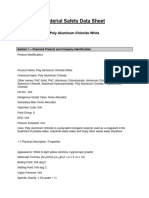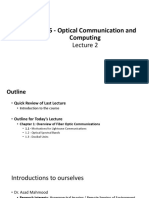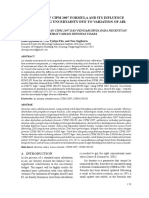Sodium Hypochlorite Solution: 1. Product Identification
Sodium Hypochlorite Solution: 1. Product Identification
Uploaded by
nasser kamakenCopyright:
Available Formats
Sodium Hypochlorite Solution: 1. Product Identification
Sodium Hypochlorite Solution: 1. Product Identification
Uploaded by
nasser kamakenOriginal Title
Copyright
Available Formats
Share this document
Did you find this document useful?
Is this content inappropriate?
Copyright:
Available Formats
Sodium Hypochlorite Solution: 1. Product Identification
Sodium Hypochlorite Solution: 1. Product Identification
Uploaded by
nasser kamakenCopyright:
Available Formats
MSDS
SODIUM HYPOCHLORITE SOLUTION
1. === Product Identification ===
2. === Composition/Information on Ingredients ===
Ingredient CAS No Percent Hazardous
Sodium Hypochlorite (as NaOCl) 7681-52-9 12% Yes
Water 7732-18-5 88% No
3. === Hazards Identification ===
Emergency Overview
--------------------------
WARNING! HARMFUL IF SWALLOWED OR INHALED. CAUSES IRRITATION TO EYES AND
RESPIRATORY TRACT. CAUSES SUBSTANTIAL BUT TEMPORARY EYE INJURY.
-----------------------------------------------------------------------------------------------------------
Health Rating: 2 - Moderate
Flammability Rating: 0 - None
Reactivity Rating: 1 - Slight
Contact Rating: 2 - Moderate
Lab Protective Equip: GOGGLES; LAB COAT
Storage Color Code: Orange (General Storage)
-----------------------------------------------------------------------------------------------------------
Potential Health Effects
----------------------------------
Inhalation:
May cause irritation to the respiratory tract, (nose and throat); symptoms may include coughing and sore throat.
Ingestion:
May cause nausea, vomiting.
Skin Contact:
http://www.hvchemical.com/msds/sohy.htm (1 of 6)3.6.2008 8:52:02
MSDS
May irritate skin.
Eye Contact:
Contact may cause severe irritation and damage, especially at higher concentration.
Chronic Exposure:
A constant irritant to the eyes and throat. Low potential for sensitization after exaggerated exposure to damaged skin.
Aggravation of Pre-existing Conditions:
Persons with impaired respiratory function, or heart disorders (or disease) may be more susceptible to the effects of the
substance.
4. ===First Aid Measures ===
Inhalation:
Remove to fresh air. If not breathing, give artificial respiration. If breathing is difficult, give oxygen. Get medical attention
immediately.
Ingestion:
If swallowed, DO NOT INDUCE VOMITING. Give large quantities of water. Never give anything by mouth to an
unconscious person. Get medical attention immediately.
Skin Contact:
Immediately flush skin with plenty of water for at least 15 minutes while removing contaminated clothing and shoes. Get
medical attention immediately. Wash clothing before reuse. Thoroughly clean shoes before reuse.
Eye Contact:
Immediately flush eyes with plenty of water for at least 15 minutes, lifting lower and upper eyelids occasionally. Get
medical attention immediately.
Note to Physician:
Consider oral administration of sodium thiosulfate solutions if sodium hypochlorite is ingested. Do not administer
neutralizing substances since the resultant exothermic reaction could further damage tissue. Endotracheal intubation could
be needed if glottic edema compromises the airway. For individuals with significant inhalation exposure, monitor arterial
blood gases and chest x-ray.
5. === Fire Fighting Measures ===
Fire:
Not considered to be a fire hazard. Substance releases oxygen when heated, which may increase the severity of an existing
fire. Containers may rupture from pressure build-up.
Explosion:
This solution is not considered to be an explosion hazard. Anhydrous sodium hypochlorite is very explosive.
Fire Extinguishing Media:
Use any means suitable for extinguishing surrounding fire. Use water spray to cool fire-exposed containers, to dilute liquid,
and control vapor.
Special Information:
In the event of a fire, wear full protective clothing and NIOSH-approved self-contained breathing apparatus with full
facepiece operated in the pressure demand or other positive pressure mode.
6. === Accidental Release Measures ===
Ventilate area of leak or spill. Wear appropriate personal protective equipment as specified in Section 8. Isolate hazard area.
Keep unnecessary and unprotected personnel from entering. Contain and recover liquid when possible. Collect liquid in an
http://www.hvchemical.com/msds/sohy.htm (2 of 6)3.6.2008 8:52:02
MSDS
appropriate container or absorb with an inert material (e. g., vermiculite, dry sand, earth), and place in a chemical waste
container. Do not use combustible materials, such as saw dust. Do not flush to sewer! US Regulations (CERCLA) require
reporting spills and releases to soil, water and air in excess of reportable quantities. The toll free number for the US Coast
Guard National Response Center is (800) 424-8802.
7. === Handling and Storage ===
Keep in a tightly closed container, stored in a cool, dry, ventilated area. Protect against physical damage. Isolate from
incompatible substances. Containers of this material may be hazardous when empty since they retain product residues
(vapors, liquid); observe all warnings and precautions listed for the product.
8. === Exposure Controls /Personal Protection ===
Airborne Exposure Limits:
Sodium Hypochlorite:
AIHA (WEEL) - STEL - 2 mg/m3
-OSHA Permissible Exposure Limit (PEL):
0.5 ppm (TWA), 1 ppm (STEL) as Chlorine
-ACGIH Threshold Limit Value (TLV):
1 ppm (TWA), 3 ppm (STEL) as Chlorine
Ventilation System:
A system of local and/or general exhaust is recommended to keep employee exposures below the Airborne Exposure Limits.
Local exhaust ventilation is generally preferred because it can control the emissions of the contaminant at its source,
preventing dispersion of it into the general work area. Please refer to the ACGIH document, Industrial Ventilation, A
Manual of Recommended Practices, most recent edition, for details.
Personal Respirators (NIOSH Approved):
If the exposure limit is exceeded and engineering controls are not feasible, a full facepiece respirator with an acid gas
cartridge may be worn up to 50 times the exposure limit or the maximum use concentration specified by the appropriate
regulatory agency or respirator supplier, whichever is lowest. For emergencies or instances where the exposure levels are not
known, use a full-facepiece positive-pressure, air-supplied respirator. WARNING: Air purifying respirators do not protect
workers in oxygen-deficient atmospheres.
Skin Protection:
Wear impervious protective clothing, including boots, gloves, lab coat, apron or coveralls, as appropriate, to prevent skin
contact.
Eye Protection:
Use chemical safety goggles and/or a full face shield where splashing is possible. Maintain eye wash fountain and quick-
drench facilities in work area.
9. === Physical/Chemical Properties ===
Appearance:
Colorless to yellowish liquid.
Odor:
Chlorine-like odor.
http://www.hvchemical.com/msds/sohy.htm (3 of 6)3.6.2008 8:52:02
MSDS
Solubility:
100% in water.
Density:
1.07 - 1.14
pH:
9 - 10 (neutral solution-no excess sodium hydroxide)
% Volatiles by volume @ 21C (70F):
ca. 95
Boiling Point:
40C (104F) Decomposes slightly
Melting Point:
-6C (21F)
Vapor Density (Air=1):
No information found.
Vapor Pressure (mm Hg):
17.5 @ 20C (68F)
Evaporation Rate (BuAc=1):
No information found.
10. === Stability and Reactivity Data ===
Stability:
Slowly decomposes on contact with air. Rate increases with the concentration and temperature. Exposure to sunlight
accelerates decomposition. Sodium hypochlorite becomes less toxic with age.
Hazardous Decomposition Products:
Emits toxic fumes of chlorine when heated to decomposition. Sodium oxide at high temperatures.
Hazardous Polymerization:
Will not occur.
Incompatibilities:
Ammonia (chloramine gas may evolve),amines, ammonium salts, aziridine, methanol, phenyl acetonitrile, cellulose,
ethyleneimine, oxidizable metals, acids, soaps, and bisulfates.
Conditions to Avoid:
Light, heat, incompatibles.
11. === Toxicological Information ===
No LD50/LC50 information found relating to normal routes of occupational exposure. Investigated as a
tumorigen and mutagen. Irritation data: eye, rabbit, 10 mg - Moderate
--------\Cancer Lists\------------------------------------------------------
---NTP Carcinogen---
Ingredient Known Anticipated IARC Category
------------------------------------ ----- ----------- -------------
Sodium Hypochlorite (as NaOCl) No No 3
(7681-52-9)
Water (7732-18-5) No No None
http://www.hvchemical.com/msds/sohy.htm (4 of 6)3.6.2008 8:52:02
MSDS
12. === Ecological Information ===
Environmental Fate:
No information found.
Environmental Toxicity:
No information found.
13. === Disposal Considerations ===
Dilute with water and flush to sewer if local ordinances allow, otherwise, whatever cannot be saved for recovery or
recycling should be managed in an appropriate and approved waste disposal facility. Processing, use or contamination of this
product may change the waste management options. State and local disposal regulations may differ from federal disposal
regulations. Dispose of container and unused contents in accordance with federal, state and local requirements.
14. === MSDS Transport Information ===
DOT: Hypochlorite Solutions, 8, UN 1791, PG III
15. === Regulatory Information ===
--------\Chemical Inventory Status - Part 1\---------------------------------
Ingredient TSCA EC Japan Australia
----------------------------------------------- ---- --- ----- ---------
Sodium Hypochlorite (as NaOCl) (7681-52-9) Yes Yes Yes
Yes
Water (7732-18-5) Yes Yes Yes
Yes
--------\Chemical Inventory Status - Part 2\---------------------------------
--Canada--
Ingredient Korea DSL NDSL Phil.
----------------------------------------------- ----- --- ---- -----
Sodium Hypochlorite (as NaOCl) (7681-52-9) Yes Yes No
Yes
Water (7732-18-5) Yes Yes No Yes
--------\Federal, State & International Regulations - Part 1\----------------
-SARA 302- ------SARA 313------
Ingredient RQ TPQ List Chemical Catg.
----------------------------------------- --- ----- ---- --------------
Sodium Hypochlorite (as NaOCl) (7681-52-9) No No No No
Water (7732-18-5) No No No No
--------\Federal, State & International Regulations - Part 2\----------------
-RCRA- -TSCA-
Ingredient CERCLA 261.33 8(d)
http://www.hvchemical.com/msds/sohy.htm (5 of 6)3.6.2008 8:52:02
MSDS
----------------------------------------- ------ ------ ------
Sodium Hypochlorite (as NaOCl) 100 No No
(7681-52-9)
Water (7732-18-5) No No
No
Chemical Weapons Convention: No TSCA 12(b): No CDTA: No
SARA 311/312: Acute: Yes Chronic: No Fire: No Pressure: No
Reactivity: No (Mixture / Liquid)
Australian Hazchem Code: None allocated.
Poison Schedule: S5
16. === Other Information ===
NFPA Ratings: Health: 2 Flammability: 0 Reactivity: 1
Label Hazard Warning:
WARNING! HARMFUL IF SWALLOWED OR INHALED. CAUSES IRRITATION TO EYES AND RESPIRATORY
TRACT. CAUSES SUBSTANTIAL BUT TEMPORARY EYE INJURY.
Label Precautions:
Avoid contact with eyes, skin and clothing.
Avoid breathing mist.
Keep container closed.
Use with adequate ventilation.
Wash thoroughly after handling.
Label First Aid:
If swallowed, DO NOT INDUCE VOMITING. Give large quantities of water. Never give anything by mouth to an
unconscious person. If inhaled, remove to fresh air. If not breathing, give artificial respiration. If breathing is difficult, give
oxygen. In case of contact, immediately flush eyes or skin with plenty of water for at least 15 minutes while removing
contaminated clothing and shoes. Wash clothing before reuse. In all cases get medical attention immediately.
Product Use:
Laboratory Reagent.
High Valley Products, Inc. provides the information contained herein in good faith but makes no representation as to its
comprehensiveness or accuracy. This document is intended only as a guide to the appropriate precautionary handling of the
material by a properly trained person using this product. Individuals receiving the information must exercise their
independent judgment in determining its appropriateness for a particular purpose.
HIGH VALLEY PRODUCTS, INC. MAKES NO REPRESENTATIONS OR WARRANTIES, EITHER EXPRESS OR
IMPLIED, INCLUDING WITHOUT LIMITATION ANY WARRANTIES OF MERCHANTABILITY, FITNESS FOR A
PARTICULAR PURPOSE WITH RESPECT TO THE INFORMATION SET FORTH HEREIN OR THE PRODUCT TO
WHICH THE INFORMATION REFERS. ACCORDINGLY, HIGH VALLEY PRODUCTS, INC. WILL NOT BE
RESPONSIBLE FOR DAMAGES RESULTING FROM USE OF OR RELIANCE UPON THIS INFORMATION.
Revision Date
http://www.hvchemical.com/msds/sohy.htm (6 of 6)3.6.2008 8:52:02
You might also like
- The Subtle Art of Not Giving a F*ck: A Counterintuitive Approach to Living a Good LifeFrom EverandThe Subtle Art of Not Giving a F*ck: A Counterintuitive Approach to Living a Good LifeRating: 4 out of 5 stars4/5 (5940)
- The Gifts of Imperfection: Let Go of Who You Think You're Supposed to Be and Embrace Who You AreFrom EverandThe Gifts of Imperfection: Let Go of Who You Think You're Supposed to Be and Embrace Who You AreRating: 4 out of 5 stars4/5 (1108)
- Never Split the Difference: Negotiating As If Your Life Depended On ItFrom EverandNever Split the Difference: Negotiating As If Your Life Depended On ItRating: 4.5 out of 5 stars4.5/5 (887)
- Hidden Figures: The American Dream and the Untold Story of the Black Women Mathematicians Who Helped Win the Space RaceFrom EverandHidden Figures: The American Dream and the Untold Story of the Black Women Mathematicians Who Helped Win the Space RaceRating: 4 out of 5 stars4/5 (925)
- Grit: The Power of Passion and PerseveranceFrom EverandGrit: The Power of Passion and PerseveranceRating: 4 out of 5 stars4/5 (598)
- Shoe Dog: A Memoir by the Creator of NikeFrom EverandShoe Dog: A Memoir by the Creator of NikeRating: 4.5 out of 5 stars4.5/5 (545)
- The Hard Thing About Hard Things: Building a Business When There Are No Easy AnswersFrom EverandThe Hard Thing About Hard Things: Building a Business When There Are No Easy AnswersRating: 4.5 out of 5 stars4.5/5 (354)
- Elon Musk: Tesla, SpaceX, and the Quest for a Fantastic FutureFrom EverandElon Musk: Tesla, SpaceX, and the Quest for a Fantastic FutureRating: 4.5 out of 5 stars4.5/5 (476)
- Her Body and Other Parties: StoriesFrom EverandHer Body and Other Parties: StoriesRating: 4 out of 5 stars4/5 (831)
- The Emperor of All Maladies: A Biography of CancerFrom EverandThe Emperor of All Maladies: A Biography of CancerRating: 4.5 out of 5 stars4.5/5 (274)
- The World Is Flat 3.0: A Brief History of the Twenty-first CenturyFrom EverandThe World Is Flat 3.0: A Brief History of the Twenty-first CenturyRating: 3.5 out of 5 stars3.5/5 (2272)
- The Yellow House: A Memoir (2019 National Book Award Winner)From EverandThe Yellow House: A Memoir (2019 National Book Award Winner)Rating: 4 out of 5 stars4/5 (99)
- The Little Book of Hygge: Danish Secrets to Happy LivingFrom EverandThe Little Book of Hygge: Danish Secrets to Happy LivingRating: 3.5 out of 5 stars3.5/5 (419)
- Devil in the Grove: Thurgood Marshall, the Groveland Boys, and the Dawn of a New AmericaFrom EverandDevil in the Grove: Thurgood Marshall, the Groveland Boys, and the Dawn of a New AmericaRating: 4.5 out of 5 stars4.5/5 (270)
- The Sympathizer: A Novel (Pulitzer Prize for Fiction)From EverandThe Sympathizer: A Novel (Pulitzer Prize for Fiction)Rating: 4.5 out of 5 stars4.5/5 (122)
- Team of Rivals: The Political Genius of Abraham LincolnFrom EverandTeam of Rivals: The Political Genius of Abraham LincolnRating: 4.5 out of 5 stars4.5/5 (235)
- A Heartbreaking Work Of Staggering Genius: A Memoir Based on a True StoryFrom EverandA Heartbreaking Work Of Staggering Genius: A Memoir Based on a True StoryRating: 3.5 out of 5 stars3.5/5 (232)
- On Fire: The (Burning) Case for a Green New DealFrom EverandOn Fire: The (Burning) Case for a Green New DealRating: 4 out of 5 stars4/5 (75)
- Already On Diigo - Com Baxter, Stephen - Xeelee 02 - Timelike Infinity V30Document147 pagesAlready On Diigo - Com Baxter, Stephen - Xeelee 02 - Timelike Infinity V30sicbuddahNo ratings yet
- The Unwinding: An Inner History of the New AmericaFrom EverandThe Unwinding: An Inner History of the New AmericaRating: 4 out of 5 stars4/5 (45)
- CPE Reading - Excercise 1Document1 pageCPE Reading - Excercise 1Erika Pérez Camacho100% (1)
- MSDS - Kempac 20 Kemwater Pax-14 (Eng)Document5 pagesMSDS - Kempac 20 Kemwater Pax-14 (Eng)nasser kamakenNo ratings yet
- Safety Data Sheet Ultrasil 110: Page 1 of 5 A001Document5 pagesSafety Data Sheet Ultrasil 110: Page 1 of 5 A001nasser kamakenNo ratings yet
- Safety Data Sheet Ultrasil 75: Page 1 of 5 S001: HNO3Document5 pagesSafety Data Sheet Ultrasil 75: Page 1 of 5 S001: HNO3nasser kamakenNo ratings yet
- DV - 115Document16 pagesDV - 115nasser kamakenNo ratings yet
- Caracteristiques Du FuelDocument1 pageCaracteristiques Du Fuelnasser kamakenNo ratings yet
- Pac White MsdsDocument6 pagesPac White Msdssanjuannica15No ratings yet
- Lec2 ES475 2023 UploadDocument24 pagesLec2 ES475 2023 UploadEmad RazaNo ratings yet
- The Role of Oxygen in Brewing: Technical Summary 3Document3 pagesThe Role of Oxygen in Brewing: Technical Summary 3Nguyễn Tất Hoàn VũNo ratings yet
- 400 SeriesDocument37 pages400 SeriesShashank SaxenaNo ratings yet
- IMP Physics Questions (For Boards)Document41 pagesIMP Physics Questions (For Boards)Navnath ChaudhariNo ratings yet
- Summary Physics FundamentalsDocument8 pagesSummary Physics FundamentalsJabeenAhmedNo ratings yet
- 7 Chapter - 3 PDFDocument7 pages7 Chapter - 3 PDFshashi nishakarNo ratings yet
- q2 w2 Bsg10 Resources em W T 1Document11 pagesq2 w2 Bsg10 Resources em W T 1Samantha Joy TangcoNo ratings yet
- Experimental Study On Foam ConcreteDocument5 pagesExperimental Study On Foam ConcreteEighthSenseGroupNo ratings yet
- Intro To Organic and Alkanes Revision QuestionsDocument19 pagesIntro To Organic and Alkanes Revision Questionsarychan418No ratings yet
- Rh-Catalyzed Oxidative Coupling Between Primary and Secondary Benzamides and Alkynes: Synthesis of Polycyclic AmidesDocument4 pagesRh-Catalyzed Oxidative Coupling Between Primary and Secondary Benzamides and Alkynes: Synthesis of Polycyclic AmidesDiogomussumNo ratings yet
- 8.4 Advanced Binary Cycles: H L H LDocument1 page8.4 Advanced Binary Cycles: H L H LJuan Ponce ManríquezNo ratings yet
- Bitsat Paper 5 SolutionDocument32 pagesBitsat Paper 5 Solutionpranka5240No ratings yet
- Application of Cipm 2007 Formula and Its Influence in Determining Uncertainty Due To Variation of Air DensityDocument7 pagesApplication of Cipm 2007 Formula and Its Influence in Determining Uncertainty Due To Variation of Air DensityAndres LarrahonaNo ratings yet
- Chen 3009 - Tutorial 1-2021Document31 pagesChen 3009 - Tutorial 1-2021Rosario QFNo ratings yet
- Atomic Spectra LabDocument11 pagesAtomic Spectra LabMarc BreslerNo ratings yet
- Turbomolecular PumpDocument10 pagesTurbomolecular PumpMustafa SayyedNo ratings yet
- List of Lists PDFDocument129 pagesList of Lists PDFYesenia Sullca RomeroNo ratings yet
- Enzymes Mode of Action of EnzymesDocument6 pagesEnzymes Mode of Action of EnzymesNamra MazherNo ratings yet
- Lithography Sequence: Lithography Process Requirements The PhotoresistDocument3 pagesLithography Sequence: Lithography Process Requirements The PhotoresiststansilawNo ratings yet
- Because There Is No Vertical Movement: 0653/41/M/J/22 © UCLES 2022Document4 pagesBecause There Is No Vertical Movement: 0653/41/M/J/22 © UCLES 2022Nadia HertiadhiNo ratings yet
- Unipak 2Document11 pagesUnipak 2Vasudev AgrawalNo ratings yet
- Acrylic Hybrid PapaerDocument6 pagesAcrylic Hybrid PapaerdShantanu98No ratings yet
- Force Measurement Between Charged PlatesDocument6 pagesForce Measurement Between Charged PlatesdarshanNo ratings yet
- Chemistry Long Quiz 5Document11 pagesChemistry Long Quiz 5Ervin MogarNo ratings yet
- Chapter 3 - Metals and Non-Metals (Part 1)Document12 pagesChapter 3 - Metals and Non-Metals (Part 1)VarunNo ratings yet
- PHD Students 2019 2020Document71 pagesPHD Students 2019 2020mmurugesh_rajNo ratings yet
- CB 504course MaterialDocument270 pagesCB 504course MaterialAnonymous u3sNldnR100% (1)











































































